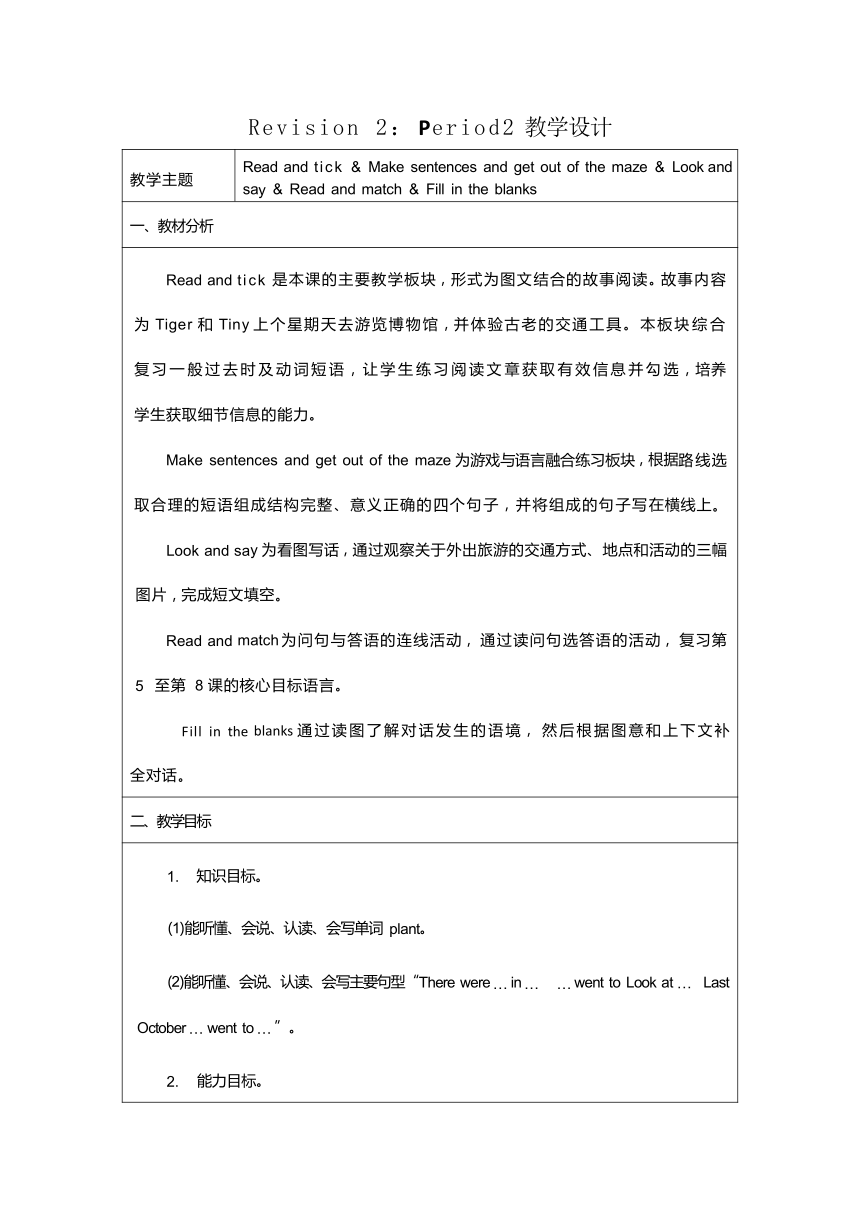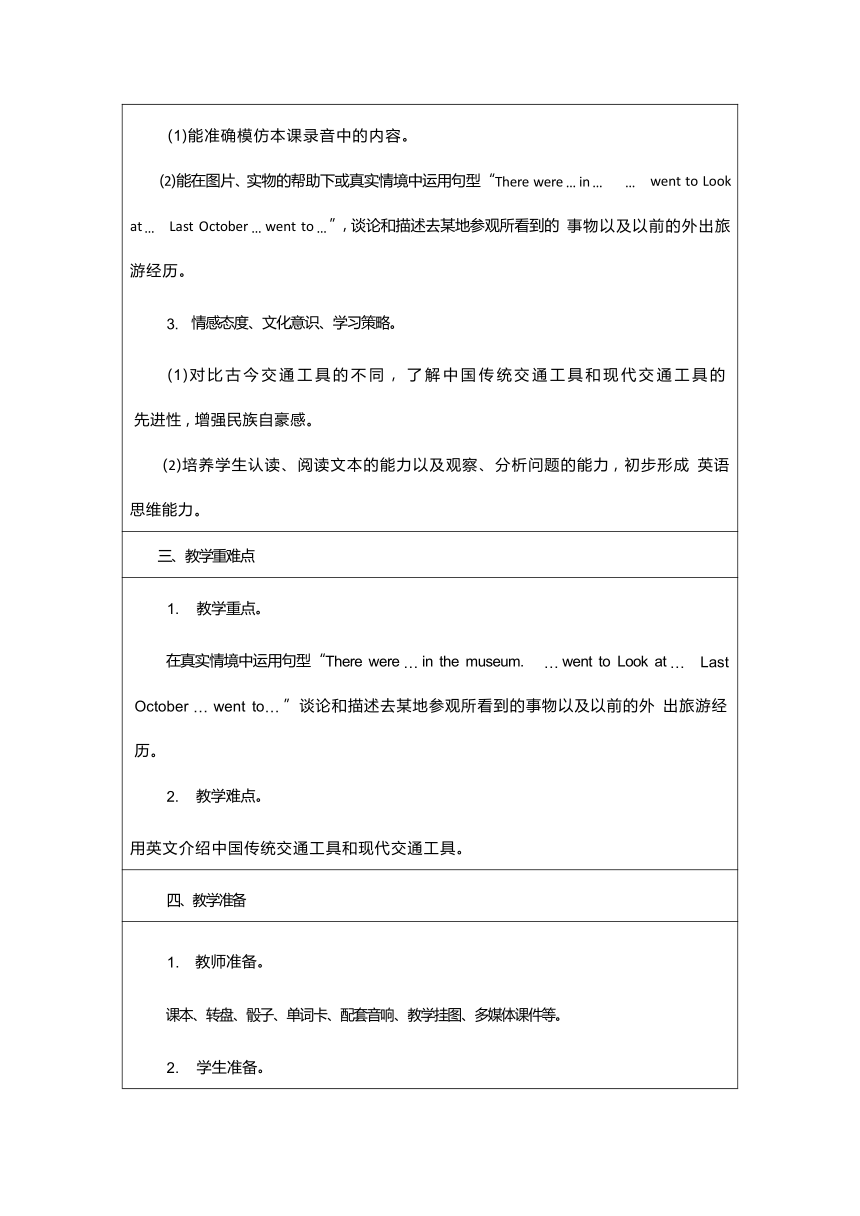Revision 2 Period 2表格式教学设计--2024-2025学年六年级上《英语》(接力版)(三起)
文档属性
| 名称 | Revision 2 Period 2表格式教学设计--2024-2025学年六年级上《英语》(接力版)(三起) |  | |
| 格式 | docx | ||
| 文件大小 | 25.5KB | ||
| 资源类型 | 教案 | ||
| 版本资源 | 接力版 | ||
| 科目 | 英语 | ||
| 更新时间 | 2025-06-22 17:23:11 | ||
图片预览


文档简介
Revision 2:Period2教学设计
教学主题 Read and tick & Make sentences and get out of the maze & Look and say & Read and match & Fill in the blanks
一、教材分析
Read and tick是本课的主要教学板块 , 形式为图文结合的故事阅读。故事内容为Tiger和Tiny上个星期天去游览博物馆 , 并体验古老的交通工具。本板块综合复习一般过去时及动词短语 , 让学生练习阅读文章获取有效信息并勾选 , 培养学生获取细节信息的能力。 Make sentences and get out of the maze为游戏与语言融合练习板块 , 根据路线选取合理的短语组成结构完整、意义正确的四个句子 , 并将组成的句子写在横线上。 Look and say为看图写话 , 通过观察关于外出旅游的交通方式、地点和活动的三幅图片 , 完成短文填空。 Read and match为问句与答语的连线活动 , 通过读问句选答语的活动 , 复习第 5 至第 8课的核心目标语言。 Fill in the blanks通过读图了解对话发生的语境 , 然后根据图意和上下文补全对话。
二、教学目标
1. 知识目标。 (1)能听懂、会说、认读、会写单词 plant。 (2)能听懂、会说、认读、会写主要句型“There were … in … … went to Look at … Last October … went to … ”。 2. 能力目标。 (1)能准确模仿本课录音中的内容。 (2)能在图片、实物的帮助下或真实情境中运用句型“There were … in … … went to Look at … Last October … went to … ”, 谈论和描述去某地参观所看到的 事物以及以前的外出旅游经历。 3. 情感态度、文化意识、学习策略。 (1)对比古今交通工具的不同 , 了解中国传统交通工具和现代交通工具的 先进性 , 增强民族自豪感。 (2)培养学生认读、阅读文本的能力以及观察、分析问题的能力 , 初步形成 英语思维能力。
三、教学重难点
1. 教学重点。 在真实情境中运用句型“There were … in the museum. … went to Look at … Last October … went to… ”谈论和描述去某地参观所看到的事物以及以前的外 出旅游经历。 2. 教学难点。 用英文介绍中国传统交通工具和现代交通工具。
四、教学准备
1. 教师准备。 课本、转盘、骰子、单词卡、配套音响、教学挂图、多媒体课件等。 2. 学生准备。 课本。
五、教学流程设计
1. 热身活动。 (1)师生用英语互致问候。 (2)教师运用多媒体课件出示交通工具的图片 , 学生快速说出对应的名称。 2. 新知呈现与操练。 (1)Read and tick板块教学。 ①师生一起观察本板块第1幅图片并讨论:“ Look , they are Tiny and Tiger. where did they go last Sunday Let ’s read Paragraph 1. ”。学生读完后 , 教师继续提问:“what did they see in the museum Please guess. ”, 鼓励学生发 散思维 , 联系背景知识进行预测。 ②教师通过多媒体课件出示本板块第 2 幅图片:“where ,s Tiny what's he doing ”。教师引导学生观察图片并鼓励学生运用所学语言描述图片 。教师 指导 学 生 阅 读 文 章 第 二 段 , 并 提 问:“ what ’s in the museum what did Tiny do ”。 ③师生一起观察本板块第 3 幅图片并阅读文章第三段 , 教师可以提问: “what did Tiger see what did he think ”。 ④学生再次听录音 , 并自己通读全文 , 然后完成文后的题目:“ what did they see ”。 ⑤学生再读短文 , 并完成短文填空。 Tiger and Tiny were very happy . It was their first time to visit the museum. In the museum , a lot of planes , trains and many other fun things. Tiny went to Look at the . He was on a ship and sailed the high seas … Tiger went to look at the . He a bike with a very high seat. They had a good time. 完成填空后 , 同桌交换检查。 3. 巩固拓展。 (1)教师询问学生:“Is the museum interesting Let ’s go and visit it with them. what kind of traffic do you know What kind of traffic did you ever take ”。教师出示一些古老的交通工具图片如马车、蒸汽机车、帆船、老爷车等 , 并进行介绍 :“These are old traffic tools in thousands/hundreds of years ago. people … by … Where can we see these old traffic tools now Can we see them on the road Yes , we can see them in the museum. These are old. Let ’s see some traffic in the future. ”。然后教师出示科技博物馆和未来交通工具的图片: “Talk about your favourite things in the museum. ”。学生可发挥想象 , 畅谈自 己想象中的未来的交通工具。 (2)Make sentences and get out of the maze板块教学。 学生先独立连线走出迷宫 , 运用沿途的单词或短语组成合理的句子 , 然后 同桌相互讨论看句子是否通顺 , 之后再完成句子的书写 , 最后同桌之间相互检 查书写。 (3)Look and say板块教学。 ①教师引导学生认真观察该板块的三幅图片:“who are they what ’s in the Pictures ”。 ②教师继续提问:“Where did they go How did they go there What did they do there Let ’s Look at the pictures and say something about the pictures. ”。 ③学生完成短文填空后 , 大声朗读短文。 (4)Fill in the blanks板块教学。 教师出示本板块图片 , 引导学生就图片内容进行讨论:“ Who are they Where are they What are they doing ”, 并鼓励学生独立完成填空 , 然后师生 一起核对答案。 4. 总结。 教师引导学生梳理本节课的重点词汇和语句 , 让学生自己总结出本节课的 收获 , 形成对学习成果的自我评价。
六、作业布置
1. 听录音 , 跟读录音若干遍 , 并能熟练朗读课文。 2. 写一段短文介绍自己上个寒假是怎样度过的。
教学主题 Read and tick & Make sentences and get out of the maze & Look and say & Read and match & Fill in the blanks
一、教材分析
Read and tick是本课的主要教学板块 , 形式为图文结合的故事阅读。故事内容为Tiger和Tiny上个星期天去游览博物馆 , 并体验古老的交通工具。本板块综合复习一般过去时及动词短语 , 让学生练习阅读文章获取有效信息并勾选 , 培养学生获取细节信息的能力。 Make sentences and get out of the maze为游戏与语言融合练习板块 , 根据路线选取合理的短语组成结构完整、意义正确的四个句子 , 并将组成的句子写在横线上。 Look and say为看图写话 , 通过观察关于外出旅游的交通方式、地点和活动的三幅图片 , 完成短文填空。 Read and match为问句与答语的连线活动 , 通过读问句选答语的活动 , 复习第 5 至第 8课的核心目标语言。 Fill in the blanks通过读图了解对话发生的语境 , 然后根据图意和上下文补全对话。
二、教学目标
1. 知识目标。 (1)能听懂、会说、认读、会写单词 plant。 (2)能听懂、会说、认读、会写主要句型“There were … in … … went to Look at … Last October … went to … ”。 2. 能力目标。 (1)能准确模仿本课录音中的内容。 (2)能在图片、实物的帮助下或真实情境中运用句型“There were … in … … went to Look at … Last October … went to … ”, 谈论和描述去某地参观所看到的 事物以及以前的外出旅游经历。 3. 情感态度、文化意识、学习策略。 (1)对比古今交通工具的不同 , 了解中国传统交通工具和现代交通工具的 先进性 , 增强民族自豪感。 (2)培养学生认读、阅读文本的能力以及观察、分析问题的能力 , 初步形成 英语思维能力。
三、教学重难点
1. 教学重点。 在真实情境中运用句型“There were … in the museum. … went to Look at … Last October … went to… ”谈论和描述去某地参观所看到的事物以及以前的外 出旅游经历。 2. 教学难点。 用英文介绍中国传统交通工具和现代交通工具。
四、教学准备
1. 教师准备。 课本、转盘、骰子、单词卡、配套音响、教学挂图、多媒体课件等。 2. 学生准备。 课本。
五、教学流程设计
1. 热身活动。 (1)师生用英语互致问候。 (2)教师运用多媒体课件出示交通工具的图片 , 学生快速说出对应的名称。 2. 新知呈现与操练。 (1)Read and tick板块教学。 ①师生一起观察本板块第1幅图片并讨论:“ Look , they are Tiny and Tiger. where did they go last Sunday Let ’s read Paragraph 1. ”。学生读完后 , 教师继续提问:“what did they see in the museum Please guess. ”, 鼓励学生发 散思维 , 联系背景知识进行预测。 ②教师通过多媒体课件出示本板块第 2 幅图片:“where ,s Tiny what's he doing ”。教师引导学生观察图片并鼓励学生运用所学语言描述图片 。教师 指导 学 生 阅 读 文 章 第 二 段 , 并 提 问:“ what ’s in the museum what did Tiny do ”。 ③师生一起观察本板块第 3 幅图片并阅读文章第三段 , 教师可以提问: “what did Tiger see what did he think ”。 ④学生再次听录音 , 并自己通读全文 , 然后完成文后的题目:“ what did they see ”。 ⑤学生再读短文 , 并完成短文填空。 Tiger and Tiny were very happy . It was their first time to visit the museum. In the museum , a lot of planes , trains and many other fun things. Tiny went to Look at the . He was on a ship and sailed the high seas … Tiger went to look at the . He a bike with a very high seat. They had a good time. 完成填空后 , 同桌交换检查。 3. 巩固拓展。 (1)教师询问学生:“Is the museum interesting Let ’s go and visit it with them. what kind of traffic do you know What kind of traffic did you ever take ”。教师出示一些古老的交通工具图片如马车、蒸汽机车、帆船、老爷车等 , 并进行介绍 :“These are old traffic tools in thousands/hundreds of years ago. people … by … Where can we see these old traffic tools now Can we see them on the road Yes , we can see them in the museum. These are old. Let ’s see some traffic in the future. ”。然后教师出示科技博物馆和未来交通工具的图片: “Talk about your favourite things in the museum. ”。学生可发挥想象 , 畅谈自 己想象中的未来的交通工具。 (2)Make sentences and get out of the maze板块教学。 学生先独立连线走出迷宫 , 运用沿途的单词或短语组成合理的句子 , 然后 同桌相互讨论看句子是否通顺 , 之后再完成句子的书写 , 最后同桌之间相互检 查书写。 (3)Look and say板块教学。 ①教师引导学生认真观察该板块的三幅图片:“who are they what ’s in the Pictures ”。 ②教师继续提问:“Where did they go How did they go there What did they do there Let ’s Look at the pictures and say something about the pictures. ”。 ③学生完成短文填空后 , 大声朗读短文。 (4)Fill in the blanks板块教学。 教师出示本板块图片 , 引导学生就图片内容进行讨论:“ Who are they Where are they What are they doing ”, 并鼓励学生独立完成填空 , 然后师生 一起核对答案。 4. 总结。 教师引导学生梳理本节课的重点词汇和语句 , 让学生自己总结出本节课的 收获 , 形成对学习成果的自我评价。
六、作业布置
1. 听录音 , 跟读录音若干遍 , 并能熟练朗读课文。 2. 写一段短文介绍自己上个寒假是怎样度过的。
